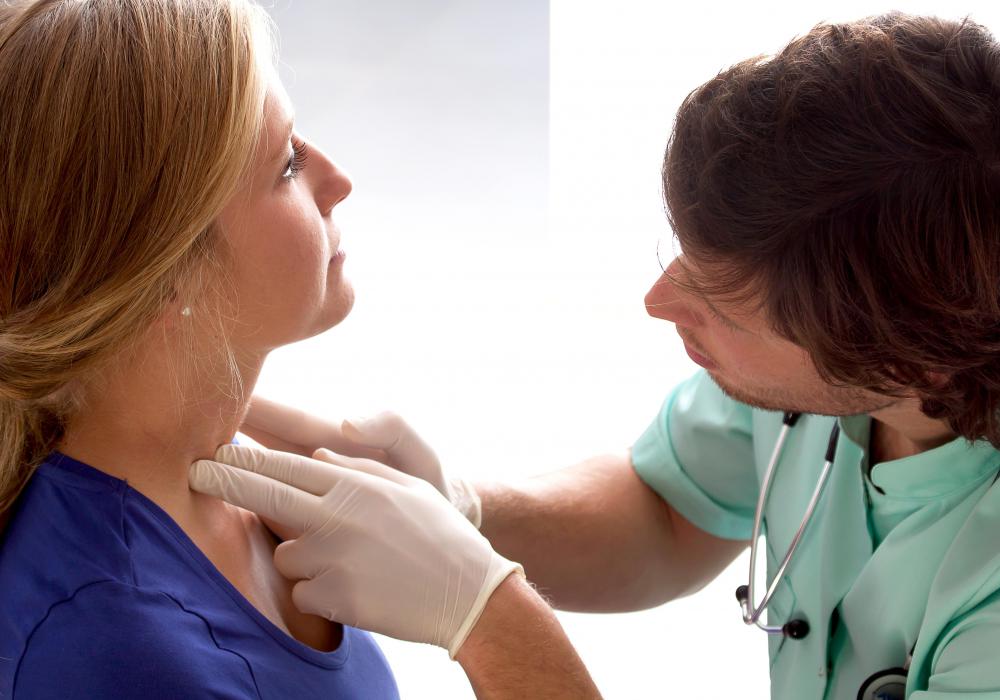At TheHealthBoard, we're committed to delivering accurate, trustworthy information. Our expert-authored content is rigorously fact-checked and sourced from credible authorities. Discover how we uphold the highest standards in providing you with reliable knowledge.
What are the Causes of a Swollen Clavicle?
The clavicle, or collarbone, forms part of the shoulder joint and is the part of the skeleton that connects the torso to the arm. Joining both to the shoulder blade and the breastbone, the clavicle is involved in a wide range of movements and, due to its position, accidental injury is common. In fact, the clavicle is more frequently broken than any other bone, leading to pain and swelling. A swollen clavicle may also be seen as a result of infection, inflammation in diseases such as arthritis, and cancer, where lymph nodes above the clavicle are sometimes involved.
Probably the most common cause of a swollen clavicle is a fracture, or breakage, of the bone. This usually occurs during a fall where one lands on the shoulder or, less often, an outstretched arm. Swelling and pain at the site of the injury will typically be experienced, along with tenderness when the area is touched. Usually, the center of the clavicle breaks and that is where swelling is seen, but sometimes the fracture occurs at the outer third of the bone, at the end where it joins the shoulder blade. Rarely, the end of the clavicle nearest the sternum breaks.

Treatment of such fractures generally involves immobilizing the arm using a sling, although in complicated cases, such as those where the broken bone has pierced the skin, patients will be referred to an orthopedics specialist for surgery. In young people, fractures are often incomplete, known as "greenstick" fractures. Here, the break occurs inside a piece of cartilage called a growth plate, leaving the outer layer of bone intact, and healing usually takes place without any special treatment. Even though it is not a full break, a greenstick fracture can still give rise to an enlarged collarbone, as can a dislocation, although this is much less common than a fracture.

Although uncommon, a joint infection from a disease such as tuberculosis can give rise to a swollen clavicle, especially in patients where the immune system is not functioning well due to conditions such as cancer or AIDS. As well as experiencing swelling, tenderness and pain, people with an infected clavicular joint may also demonstrate more general signs of illness such as fever. The affected joint is normally drained, and the patient is treated with antibiotics.

Arthritis, where joints become painful, swollen and stiff, can occasionally be the cause of a swollen clavicle. Osteoarthritis is due to wear and tear, and may affect the joint where the clavicle meets the shoulder blade. It is treated with a combination of rest and painkillers, physiotherapy and possibly surgery. Rheumatoid arthritis, where the body's immune system attacks the joint lining, may occur in any joint and is treated using medication, and exercises such as swimming.

Rarely, a swollen clavicle can be caused by a tumor of the collarbone. It is more likely for cancer to originate elsewhere and spread, leading to swelling in the lymph nodes, which lie just above the clavicle. These swollen nodes may be seen in association with cancers affecting the neck, lungs, breasts or abdomen. Treatment will depend upon the specific type of cancer, and it should be remembered that enlarged lymph nodes can also be caused by infection.
AS FEATURED ON:
AS FEATURED ON:















Discussion Comments
Can a swollen clavicle just below the neck have any effects on the throat? It feels as if the swollen bone is protruding into the throat. -- P. Holt
I had a CT scan done on my clavical bone and it was determined that I have osteoarthritis of the collarbone I have a big bump on the left bone right in the front and the pain goes all through the bone to my left shoulder. My doctor told me there is nothing he can do. Is that true? I am 66 and in good health.
Arthritis runs in my family. My grandma has it, my mom has it, and my sister has it. I'm just hoping that I don't end up with it too, although the odds don't appear to be in my favor.
Whenever I thought of arthritis though, I always pictured it being in the fingers, or the knees, or something. I had no idea that you could get collar bone swelling as a result of arthritis!
I didn't realize that there were so many things that could cause collar bone swelling. I figured that a break or a fracture would be the only reason. I had no idea it could be a sign of something worse. At least a break heals. The rest of that stuff sounds a lot harder to deal with.
I remember my cousin breaking his clavicle when we were kids. It's one of those moments that clearly sticks out in my memory, even though it was so long ago. We were playing volleyball, and my cousin decided to play in the sand on the court.
He was told to move, but before he listened, one of the people playing fell on him. The result was a broken clavicle.
I don't know how much swelling was present, but I remember a lot of screaming. He was taken to the hospital, which was quite some distance away. The weirdest part was that he fell asleep on the way to the hospital and then woke up and stretched his arms -- both of them. Somehow, it didn't hurt!
He wore a sling for awhile and then was as good as new.
Post your comments